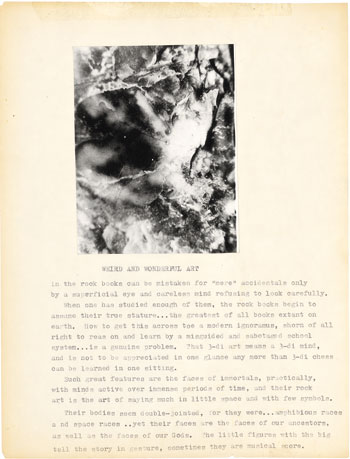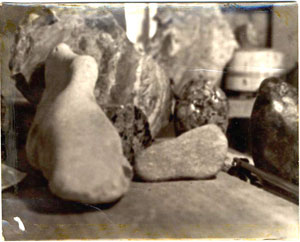
Richard Sharpe Shaver
1907-1975Weird and Wonderful Art
Rockfogos, Paintings and Books
June 11 - July 26, 2002
In 1943, Raymond A. Palmer, the editor-in-chief of Amazing Stories magazine, received a letter from Richard S. Shaver of Barto, Pennsylvania explaining that Shaver had discovered the 'key' to "Mantong," the lost alphabet of Atlantis. Palmer published these 'findings' in the January, 1944 issue of Amazing Stories and was greatly surprised by the volume of fan mail the piece engendered.
Buoyed by this first success, Shaver continued writing letters to Palmer and slowly revealed the following. Some years earlier, while working at an autobody factory in Detroit, Shaver began hearing voices in the hissing noise of his welding machine. He quickly fled and began travelling across the U.S., slowly deducing along the way that he had made telepathic contact with a subterranean race of evil 'dero' (detrimental robots) who were the degenerate remnants of an advanced civilisation of giant Titans and Atlantans, most of whom had left the earth in spaceships to escape sinister death rays from a dying sun ten thousand years before the flood. After the success of the 'Mantong' piece, Palmer used Shaver's ten thousand word manuscript titled, "Warning to Future Man," as the 'factual' basis for a far longer story that he wrote and published as "I Remember Lemuria" in March, 1945. "I Remember Lemuria" was essentially a repackaging of Shaver's delusional episodes as science fiction. But unlike most science fiction it was published with footnotes and other seemingly factual additions and became the launching pad for almost fifteen years of active pulp and fanzine 'discussions' of UFO's, hollow-earth conspiracies and what soon became known as 'The Shaver Mysteries.'
In the late 1950's, Shaver relocated from central Wisconsin to the Arkansas Ozarks, and his obsession with beings inside the earth began to be manifested in the visual arts.Richard Shaver was an autodidact who had become familiar with history, mythology, and science through a lifetime of copious reading. In Detroit in 1929, he signed up for drawing lessons sat a small art academy and attended classes there intermittently until 1932. In 1959 Shaver began collecting granite rocks from the fields around his Wisconsin home to examine and photograph with magnifying lenses. It is not clear when he made his first 'discovery' about the rocks but until the end of his life in 1975, Shaver claimed to have found evidence in these 'picture rocks' of Atlantan mermaids and mermen, and Lemurian titans, who inhabited earth before the 'seven moon falls' and the biblical deluge. Slicing the rocks and photographing enlarged projections of their sections, Shaver zeroed in on their faces, nude women, frolicking mer-people, and prehistoric animals that were, to him, so obviously visible in the random patterns of the stones' crystal compositions. He spent untold hours capturing these 'rokfogo' images on film and printing them in his own darkroom. Shaver then used these 'scientific' pictures as illustrations for his own short texts and hand made books. Originally based upon imagery he perceived in his 'picture rocks', and later manifested on rough masonite by the 'same forces' that had imprinted the rocks with pictures 'from days of yore', Shaver made a large number of rivetingly bizarre paintings. The interconnected, overlapping nudes, screaming demons, web-footed mer people, and Norse gods he found in the glue and paint surfaces of these crusty works erupt and coalesce from random surface imperfections like geological strata. In 1975, Ray Palmer published many of Shaver's paintings and rock photos in a hardcover book, The Secret World.
All aspects of Shavers work will be on exhibit at the gallery: original issues of his stories in Amazing Stories and The Hidden World, a large selection of rock-fogos, paintings as well as unpublished texts in manuscript form and unique prototypes of books handmade by Shaver towards the end of his life in the hopes of publication.
Mer feet
(Mermaid show form for when they began to emerge onto land
and needed foot protection)
Black & White Photograph
4" x 5"